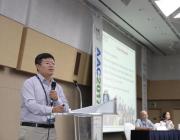摘要:
To better understand the sources, formation, and the transport of air pollutants over North China Plain (NCP), a four-week intensive campaign during summertime in 2014 was conducted in a central NCP rural site. In this study, particle hygroscopicity and volatility measurements were focused to characterize the thermodynamic properties of nanoparticles and gain insight into chemical composition of nanoparticles during the new particle formation (NPF) events. The water-soluble fractions of 30 and 50 nm newly formed particles were respectively 0.64 +/- 0.06 and 0.61 +/- 0.06, indicating that the water-soluble chemical compounds, most likely ammonium sulfate, dominated the condensational growth of newly formed particles over the NCP. Due to containing higher water-soluble fraction, nanoparticles can be activated as cloud condensation nuclei (CCN) at lower supersaturation in the atmosphere of NCP in contrast to cleaner environments, such as Melpitz (Central European background) and Hyytiala (boreal forest) during the NPF events. Our observations showed that the NPF and subsequent growth significantly resulted in an enhancement in CCN number concentration. The ranges of enhancement factors of CCN number concentration for supersaturation (SS) = 0.2, 0.4, 0.8% were respectively 1.9-7.0, 2.7-8.4, and 3.6-10.1. After being heated to 300 degrees C, the shrink factors for 30 and 50 nm particles were respectively 0.35 and 038. This indicated that non-volatile compounds could be produced during the growth process of newly formed particles. (C) 2017 Elsevier B.V. All rights reserved.附注:
ISI Document Delivery No.: EM9CQTimes Cited: 3Cited Reference Count: 64Wu, Z. J. Ma, N. Groess, J. Kecorius, S. Lu, K. D. Shang, D. J. Wang, Y. Wu, Y. S. Zeng, L. M. Hu, M. Wiedensohler, A. Zhang, Y. H.Wu, Zhijun/A-7041-2012; Ma, Nan/L-1282-2013; Zeng, Limin/D-3948-2013; Zhang, Yuanhang/F-7038-2011; Ma, Nan/I-8657-2012; Lu, Keding/A-7282-2012Ma, Nan/0000-0003-4006-1003; Ma, Nan/0000-0003-4494-3337; Lu, Keding/0000-0001-9425-9520National Natural Science Foundation of China [21190052, 41475127, 41571130021, 91544214, 41121004]; Non-profit Research Projects of Environmental Protection Department of China [201409010]; National Basic Research Program of China [2013CB228503]; State Key Joint Laboratory of Environment Simulation and Pollution Control [14L02ESPC]; Sino-German Science Center project [GZ663]; Collaborative Innovation Center for Regional Environmental QualityThis work is supported by the following projects: National Natural Science Foundation of China (21190052, 41475127 , 41571130021, 91544214, 21190052, and 41121004), the Non-profit Research Projects of Environmental Protection Department of China (201409010), the National Basic Research Program of China (2013CB228503), Special Fund of State Key Joint Laboratory of Environment Simulation and Pollution Control (14L02ESPC), Sino-German Science Center project (GZ663), and the Collaborative Innovation Center for Regional Environmental Quality.3440Elsevier science incNew york1873-2895